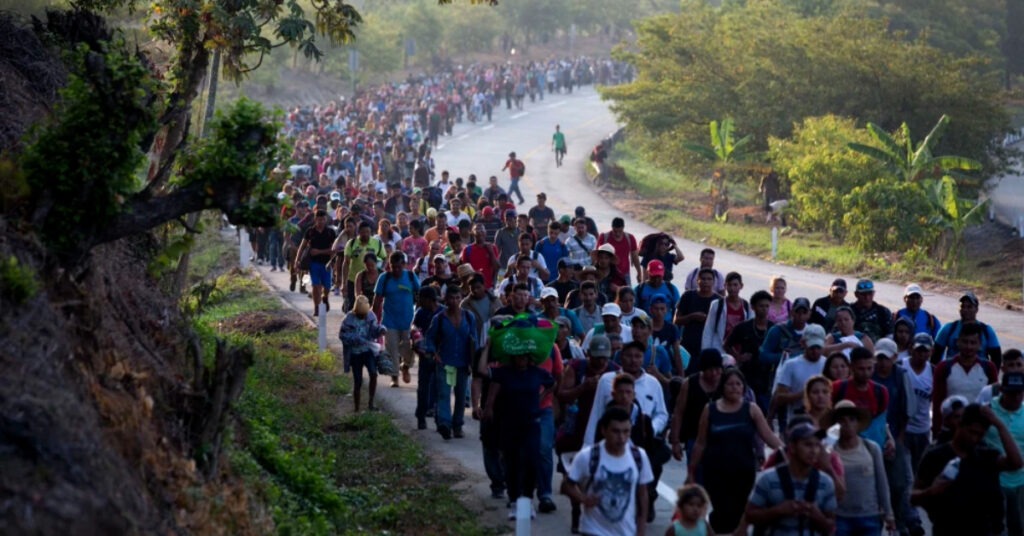In 2023, Mexico witnessed an unprecedented surge in the number of migrants seeking refuge within its borders, with 381,000 people traversing the national territory, according to the United Nations Refugee Agency (UNHCR). Among them, a record-breaking 140,000 asylum applications were filed. This rise in migration, fueled by various socioeconomic and political factors, was highlighted during a recent panel titled “For the Right to Migrate,” hosted by the National Autonomous University of Mexico (UNAM).
Mario Luis Fuentes Alcalá, head of the Extraordinary Chair on Human Trafficking at UNAM, described the complexities of migration today, pointing out that there are both “horizontal” and “vertical” borders. “Horizontal” borders refer to the physical barriers and national boundaries that restrict the flow of migrants. In contrast, “vertical” borders represent the growing obstacles, risks, and threats, such as human trafficking and organized crime, that prevent migrants from continuing their journeys safely.
“Today there are not only horizontal borders, those that try to stop the flow of human beings, but also vertical ones, that is, obstacles, risks, and threats that prevent them from continuing to walk,” Fuentes Alcalá explained. These barriers force many migrants to pause their journeys, seeking shelter under bridges, in parks, church atriums, and public squares, as formal shelters and migrant houses remain overwhelmed by the influx.
Mexico’s Internal Displacement Crisis
Fuentes Alcalá further emphasized that migration is not limited to foreign nationals; Mexicans are also being displaced within their own country. He pointed out that 8,659 Mexicans have been forced to move due to threats from organized crime or natural disasters so far in 2023. Since 2008, over 392,000 Mexicans have left regions like Zacatecas and the Highlands of Chiapas in search of security and economic opportunities.
In addition to those fleeing violence, migrant day laborers—more than 1.2 million of whom remain invisible in official statistics—face their own set of challenges. These internal migrants, often moving seasonally to work in agriculture, struggle with the same precarious living conditions and lack of protection as international migrants.
Vulnerable Populations Among Migrants
Fuentes Alcalá also underscored the vulnerabilities of different migrant groups. Women account for 30% of those walking the migration routes, with many of them pregnant. Men represent 70% of the migrants, 46% of whom are aged 18 to 34. Families and minors, including unaccompanied children, make up a significant portion of the population on the move, adding layers of complexity to the humanitarian crisis.
Meanwhile, the Center for Education for Foreigners (CEPE) at UNAM, led by Anel Pérez Martínez, highlighted the shifting motivations behind migration. According to Pérez Martínez, migration today is no longer solely about economic or educational opportunities. Increasingly, it is driven by violence—gender-based, military, social, or economic—that forces individuals to flee their homes and abandon their native language and culture.
“Currently, migrating does not necessarily have to do with the privilege of going to study from one country to another, but with leaving the place of residence due to a condition of gender, military, social, or economic violence,” Pérez Martínez explained during the panel.
Art and Human Rights: A Platform for Reflection
Art, according to the speakers, provides an important platform for reflecting on the phenomenon of migration and its intersection with human rights. Pérez Martínez noted that initiatives such as the traveling poster exhibition “Movement and Permanence: For the Right to Migrate” allow society to “move and be moved” by the stories and experiences of migrants. Art serves not only as a form of expression but also as a means to foster empathy and a deeper understanding of the human condition in the context of displacement.
Bruno Velázquez Delgado, coordinator of the Nelson Mandela Chair of Human Rights in the Arts at UNAM, emphasized the need to consider the reality of migrants’ experiences. “One cannot speak of migrants who pursue a dream without knowing that countless people, many of them displaced children, are on the run, terrified, escaping from a nightmare where the only certainty is that nothing else remains for them,” Velázquez Delgado remarked. He pointed to the precariousness, anguish, and uncertainty that characterize the lives of many migrants, especially children, who face a daily struggle for survival.
The Global Context: Human Trafficking and Slavery
The migration crisis in Mexico also sheds light on the broader global issue of human trafficking and modern slavery. According to estimates from the United Nations Office on Drugs and Crime (UNODC), there are approximately 2.5 million people worldwide who are victims of slavery. For every one person identified as a victim, there are 20 more who remain unidentified, bringing the total number of enslaved individuals to around 50 million. The majority of these victims are women and girls, many of whom are trapped in sexual exploitation.
As migration flows through Mexico continue to grow, the humanitarian challenges that accompany them become more complex. The surge in asylum applications, the collapse of shelters, and the increasing visibility of vulnerable populations underscore the urgent need for comprehensive solutions that address the root causes of migration and provide adequate protection for those on the move. The ongoing discussions at UNAM and other institutions highlight the importance of viewing migration not only as a political or economic issue but as a fundamental human rights concern.
This growing crisis calls for immediate attention, not just from Mexico, but from the international community as well, as millions of lives hang in the balance amid precarious conditions, uncertain futures, and the ever-present risks of exploitation and violence.
